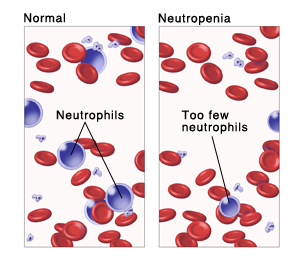Just a little update, as we wait for the "big" update on 5.17.17
Received a call late today, that my blood tests (which I took earlier today), revealed that I'm ... can you guess??? Wait for it.... Yes, I'm NEUTROPENIC ... again! Most likely from my 3 weeks of Pomalyst, even though I've been doing a lower dose of alternating (daily), 2mg with 3mg.
The irony was Jim and I were out to a spontaneous late lunch when the call came in, but I ignored it and let it go to voicemail, as I didn't want to hear "bad news" at that moment. Ironic, this was my Darzalex infusion break week, thus I had packed in an event almost everyday- ooppsy, potential cootie contamination! Not to mention I attended the first of my retirement celebrations (with a lot of people and cooties), not to mention I am still picking up the horse "apples" as my daily exercise, not to mention that I am still cleaning and diapering our 20 year old disabled cat and doing the litter boxes, and not to mention all the other tasks and (few) events I do... which a NEUTROPENIC, IMMUNE COMPROMISED cancer patient should not. Oh Boy! I really didn't think my WBCs were this status again.
Fortunately, if I'm out and about in public, which is not often lol, I'm quite "OCD" regarding not shaking hands, not being close to people, not touching public things, and always using wipes and alcohol hand spray (which I make from Isopropyl alcohol and a bit of scent from Bath and Body sprays, or Wintergreen Mint Isopropyl alcohol). People think I'm way over the top about this, but DANG IT, these blood tests PROVE my self protection and ultra caution is valid, smart and proactive. I think about all the events this week, and even though I've been "exposed" to cooties, I practiced my usual super cautious cleanliness, and I'm sure glad I did. I've always been super clean, but my myeloma status forced me to be additionally careful and cautious. So take that, those that think I'm ridiculous! I will "brag" here, that I have never been hospitalized for an illness (other than my SCT), never have had Pneumonia, Bronchitis, or a flu that needed antibiotics, etc. So even though my immune system is "dangerously compromised"... knock on beautiful wood, I've fought off the cooties effectively!
So hello Neutropenic diet, I will be a bit more cautious, and not eat fresh fruits and veggies now that I know my current status. But ooopppsss, that's exactly what I did this week. Cross your fingers, I'll be ok, and there aren't any microbial cooties swirling around in my system, ready to attack!
Can you believe this? I can't. But yet I can. Every time I allow myself to feel just a little bit "normal" and engage in a few "normal" things, boom!, I receive my "reality check" loud and clear. Wonder what other "interesting news" my blood tests will reveal? What's your guess? I'm hoping Darzalex is still pummeling those annoying myeloma cells, even though I'm on the new every other week protocol. I'll report back on 5.17.17












Julie..hoping for positive results today..savour every retirement celebration..and remain vigilant. Thanks for sharing your journey. Your encouraging words and suggestions have helped me cope with the emotional and physical aspects of my husband's myeloma..your goodness is evident in your writings..thank you ..Karen
ReplyDeleteAww, thank you so much for checking in Karen and letting me know you continue to enjoy my rants. My posts are raw and real and I am glad you find them helpful :)) It's still challenging for me to connect with the ongoing, never ending aspects of a myeloma Dx. I keep thinking someone will tell me, "just kidding", you're fine lol. Hoping your hubby is doing ok, and you both are finding bright spots daily. Even on "bad days" I look for the positive. And on "good days" I rejoice in feeling a bit "normal". Hoping you 2 find joy daily. Thank you Karen. xoxo :))
ReplyDelete